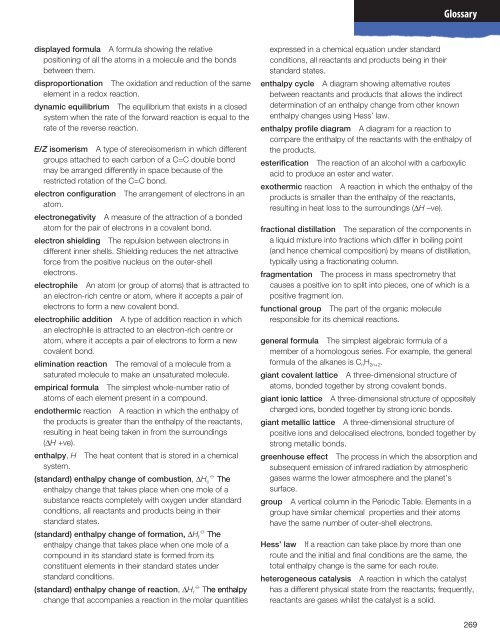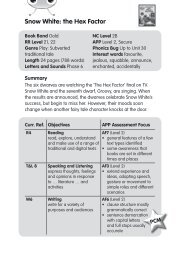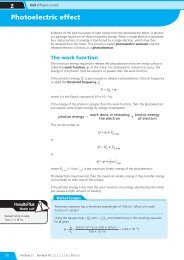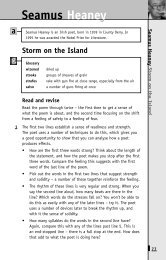Unit 1 Module 3 The Periodic Table - Pearson Schools
Unit 1 Module 3 The Periodic Table - Pearson Schools
Unit 1 Module 3 The Periodic Table - Pearson Schools
Create successful ePaper yourself
Turn your PDF publications into a flip-book with our unique Google optimized e-Paper software.
Glossary<br />
displayed formula A formula showing the relative<br />
positioning of all the atoms in a molecule and the bonds<br />
between them.<br />
disproportionation <strong>The</strong> oxidation and reduction of the same<br />
element in a redox reaction.<br />
dynamic equilibrium <strong>The</strong> equilibrium that exists in a closed<br />
system when the rate of the forward reaction is equal to the<br />
rate of the reverse reaction.<br />
E/Z isomerism A type of stereoisomerism in which different<br />
groups attached to each carbon of a C=C double bond<br />
may be arranged differently in space because of the<br />
restricted rotation of the C=C bond.<br />
electron configuration <strong>The</strong> arrangement of electrons in an<br />
atom.<br />
electronegativity A measure of the attraction of a bonded<br />
atom for the pair of electrons in a covalent bond.<br />
electron shielding <strong>The</strong> repulsion between electrons in<br />
different inner shells. Shielding reduces the net attractive<br />
force from the positive nucleus on the outer-shell<br />
electrons.<br />
electrophile An atom (or group of atoms) that is attracted to<br />
an electron-rich centre or atom, where it accepts a pair of<br />
electrons to form a new covalent bond.<br />
electrophilic addition A type of addition reaction in which<br />
an electrophile is attracted to an electron-rich centre or<br />
atom, where it accepts a pair of electrons to form a new<br />
covalent bond.<br />
elimination reaction <strong>The</strong> removal of a molecule from a<br />
saturated molecule to make an unsaturated molecule.<br />
empirical formula <strong>The</strong> simplest whole-number ratio of<br />
atoms of each element present in a compound.<br />
endothermic reaction A reaction in which the enthalpy of<br />
the products is greater than the enthalpy of the reactants,<br />
resulting in heat being taken in from the surroundings<br />
(∆H +ve).<br />
enthalpy, H <strong>The</strong> heat content that is stored in a chemical<br />
system.<br />
Ø<br />
(standard) enthalpy change of combustion, ∆H c <strong>The</strong><br />
enthalpy change that takes place when one mole of a<br />
substance reacts completely with oxygen under standard<br />
conditions, all reactants and products being in their<br />
standard states.<br />
Ø<br />
(standard) enthalpy change of formation, ∆H f <strong>The</strong><br />
enthalpy change that takes place when one mole of a<br />
compound in its standard state is formed from its<br />
constituent elements in their standard states under<br />
standard conditions.<br />
Ø<br />
(standard) enthalpy change of reaction, ∆H r <strong>The</strong> enthalpy<br />
change that accompanies a reaction in the molar quantities<br />
expressed in a chemical equation under standard<br />
conditions, all reactants and products being in their<br />
standard states.<br />
enthalpy cycle A diagram showing alternative routes<br />
between reactants and products that allows the indirect<br />
determination of an enthalpy change from other known<br />
enthalpy changes using Hess’ law.<br />
enthalpy profile diagram A diagram for a reaction to<br />
compare the enthalpy of the reactants with the enthalpy of<br />
the products.<br />
esterification <strong>The</strong> reaction of an alcohol with a carboxylic<br />
acid to produce an ester and water.<br />
exothermic reaction A reaction in which the enthalpy of the<br />
products is smaller than the enthalpy of the reactants,<br />
resulting in heat loss to the surroundings (∆H –ve).<br />
fractional distillation <strong>The</strong> separation of the components in<br />
a liquid mixture into fractions which differ in boiling point<br />
(and hence chemical composition) by means of distillation,<br />
typically using a fractionating column.<br />
fragmentation <strong>The</strong> process in mass spectrometry that<br />
causes a positive ion to split into pieces, one of which is a<br />
positive fragment ion.<br />
functional group <strong>The</strong> part of the organic molecule<br />
responsible for its chemical reactions.<br />
general formula <strong>The</strong> simplest algebraic formula of a<br />
member of a homologous series. For example, the general<br />
formula of the alkanes is C n H 2n+2 .<br />
giant covalent lattice A three-dimensional structure of<br />
atoms, bonded together by strong covalent bonds.<br />
giant ionic lattice A three-dimensional structure of oppositely<br />
charged ions, bonded together by strong ionic bonds.<br />
giant metallic lattice A three-dimensional structure of<br />
positive ions and delocalised electrons, bonded together by<br />
strong metallic bonds.<br />
greenhouse effect <strong>The</strong> process in which the absorption and<br />
subsequent emission of infrared radiation by atmospheric<br />
gases warms the lower atmosphere and the planet’s<br />
surface.<br />
group A vertical column in the <strong>Periodic</strong> <strong>Table</strong>. Elements in a<br />
group have similar chemical properties and their atoms<br />
have the same number of outer-shell electrons.<br />
Hess’ law If a reaction can take place by more than one<br />
route and the initial and final conditions are the same, the<br />
total enthalpy change is the same for each route.<br />
heterogeneous catalysis A reaction in which the catalyst<br />
has a different physical state from the reactants; frequently,<br />
reactants are gases whilst the catalyst is a solid.<br />
269<br />
935 chemistry.endmatter.indd 269 13/11/07 1:24:28 pm
















